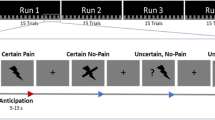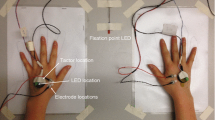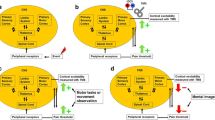Abstract
Pain serves to protect against bodily threat, and therefore initiates protective responses such as attending toward threat-relevant information. Since pain is often exacerbated by executing movements, these motor actions may serve as cues for pain. Up to date, however, pain-related attention during movement remains largely unexplored. While it has been shown that the preparation of a pain-related movement leads to enhanced processing of somatosensory information, it is unclear how the actual execution of a movement interacts with somatosensory attention. In the current study, we examined whether somatosensory processing is enhanced at a moving body part when the movement is expected to be associated with pain. Participants were asked to execute hand movements which were occasionally followed by a pain stimulus. To measure somatosensory attention, a task-irrelevant, innocuous tactile probe was presented on either hand to evoke a somatosensory evoked potential (SEP). The results showed an elevation of the N120 SEP at the hand performing a potentially painful movement, indicating heightened attention toward tactile information at the threatened moving hand compared to the non-threatened hand. Additionally, the P200 SEP also showed enlarged responses when performing a pain-related movement compared to a no-pain-related movement. These results show that not only the anticipation, but also the execution of pain-related movements, may modulate the processing of somatosensory input, driven by attentional processes.


source densities (CSD) for the PainCue_PainStim condition are presented under the waveform for both the N120 SEP (left) at 121 ms after stimulus onset and P200 (right) at 186 ms after stimulus offset
Similar content being viewed by others
References
Bulcke CV, Van Damme S, Durnez W, Crombez G (2013) The anticipation of pain at a specific location of the body prioritizes tactile stimuli at that location. Pain 154:1464–1468. https://doi.org/10.1016/jpain201305009
Clauwaert A, Torta DM, Danneels L, Van Damme S (2018) Attentional modulation of somatosensory processing during the anticipation of movements accompanying pain: an event-related potential study. J Pain. https://doi.org/10.1016/jjpain201710008
Crombez G, Van Ryckeghem DM, Eccleston C, Van Damme S (2013) Attentional bias to pain-related information: a meta-analysis. Pain 154:497–510. https://doi.org/10.1016/jpain201211013
Durnez W, Van Damme S (2017) Let it be? Pain control attempts critically amplify attention to somatosensory input. Psychol Res 81:309–320. https://doi.org/10.1007/s00426-015-0712-7
Eccleston C, Crombez G (1999) Pain demands attention: a cognitive–affective model of the interruptive function of pain. Psychol Bull 125:1133–1159. https://doi.org/10.1037/0033-29091253356
Eimer M, Forster B (2003) Modulations of early somatosensory ERP components by transient and sustained spatial attention. Exp Brain Res 151:24–31. https://doi.org/10.1007/s00221-003-1437-1
Field AP, Storksen-Coulson H (2007) The interaction of pathways to fear in childhood anxiety: a preliminary study. Behav Res Ther 45:3051–3059. https://doi.org/10.1016/jbrat200709001
Filbrich L, Torta D, Vanderclausen C, Azanon E, Legrain V (2016) Using temporal order judgments to investigate attention bias toward pain and threat-related information methodological and theoretical issues. Conscious Cogn 41:135–138. https://doi.org/10.1016/jconcog201602008
Fiorio M, Recchia S, Corrà F, Siimonetto S, Garcia-Larrea L, Tinazzi M (2012) Enhancing non-noxious perception: behavioural and neurophysiological correlates of a placebo-like manipulation. Neuroscience 16:96–104. https://doi.org/10.1016/jneuroscience201204066
Forster B, Eimer M (2007) Covert unimanual response preparation triggers attention shifts to effectors rather than goal locations. Neurosci Lett 419:142–146
Forster B, Gillmeister H (2011) ERP investigation of transient attentional selection of single and multiple locations within touch. Psychophysiology 48:788–796. https://doi.org/10.1111/j1469-8986201001147x
Franz M, Nickel MM, Ritter A, Miltner WH, Weiss T (2015) Somatosensory spatial attention modulates amplitudes latencies and latency jitter of laser-evoked brain potentials. J Neurophysiol 113:2760–2768. https://doi.org/10.1152/jn000702015
Garcia-Larrea L, Bastuji H, Mauguière F (1991) Mapping study of somatosensory evoked potentials during selective spatial attention. Electrocephalogr Clin Neurophysiol 8:201–214
García-Larrea L, Bastuji H, Mauguière F (1995) Somatosensory responses during selective spatial attention: N120–N140 transition. Psychophysiology 32:526–537. https://doi.org/10.1111/j1469-89861995tb01229x
Gertz H, Voudouris D, Fiehler K (2017) Reach-relevant somatosensory signals modulate tactile suppression. J Neurophysiol 117:2262–2268. https://doi.org/10.1152/jn000522017
Gratton G, Coles MGH, Donchin E (1983) A New method for off-line removal of ocular artifact. Electroencephalogr Clin Neurophysiol 55:468–484. https://doi.org/10.1016/0013-4694(83)90135-9
JASP Team (2019) JASP (Version 0110)
Jeffreys H (1961) Theory of probability, 3rd edn. Oxford University Press, Oxford
Job XE, de Fockert JW, van Velzen J (2016) Action preparation modulates sensory perception in unseen personal space: an electrophysiological investigation. Neuropsychologia 89:445–452
Juravle G, Deubel H, Spence C (2011) Attention and suppression affect tactile perception in reach-to-grasp movements. Acta Psychol 138:302–310. https://doi.org/10.1016/jactpsy201108001
Juravle G, Heed T, Spence C, Röder B (2016) Neural correlates of tactile perception during pre- peri- and post-movement. Exp Brain Res 234:1293–1302. https://doi.org/10.1007/s00221-016-4589-5
Juravle G, Binsted G, Spence C (2017) Tactile suppression in goal-directed movement. Psychon Bull Rev 24:1060–1076. https://doi.org/10.3758/s13423-016-1203-6
Kida T, Wasaka T, Nakata H, Akatsuka K, Kakigi R (2006) Active attention modulates passive attention-related neural responses to a sudden somatosensory input against a silent background. Exp Brain Res 175:609–617. https://doi.org/10.1007/s00221-006-0578-4
Leeuw M, Goossens MEJB, Linton SJ, Crombez G, Boersma K, Vlaeyen JWS (2006) The Fear-avoidance model of musculoskeletal pain: current state of scientific evidence. J Behav Med 30:77–94. https://doi.org/10.1007/s10865-006-9085-0
Luck SJ (2005) An introduction to the event-related potential technique. MIT Press, Cambridge
Luck SJ, Gaspelin N (2017) How to get statistically significant effects in any ERP experiment (and why you shouldn’t). Psychophysiology 54:146–157. https://doi.org/10.1111/psyp12639
Meulders A, Vlaeyen JWS (2013) The acquisition and generalization of cued and contextual pain-related fear: an experimental study using a voluntary movement paradigm. Pain 154:272–282
Meulders A, Vansteenwegen D, Vlaeyen JWS (2011) The acquisition of fear of movement-related pain and associative learning: a novel pain-relevant human fear conditioning paradigm. Pain 152:2460–2469. https://doi.org/10.1016/jpain201105015
Ploghaus A, Tracey I, Gati JS, Clare S, Menon RS, Metthews PM, Rawlins JN (1999) Dissociating pain from its anticipation in the human brain. Science 284:1979–1981
Porro CA, Baraldi P, Pagnoni G, Serafini M, Facchin P, Maieron M, Nichelli P (2002) Does anticipation of pain affect cortical nociceptive systems. J Neurosci 22:3206–3214
Porro CA, Cettolo V, Francescato MP, Baraldi P (2003) Functional activity mapping of the mesial hemispheric wall during anticipation of pain. NeuroImage 19:1738–1747
Raes AK, De Houwer J, De Schryver M, Brass M, Kalisch R (2014) Do CS-US pairings actually matter? A within-subject comparison of instructed fear conditioning with and without actual CS-US pairings. PLoS ONE 9:e84888. https://doi.org/10.1371/journal.pone.0084888
Rizzolatti G, Riggio L, Sheliga BM (1994) Space and selective attention attention and performance, vol XV. MIT Press, Cambridge, pp 231–265
Roelofs J, Peters ML, Muris P, Vlaeyen JW (2002) Dutch version of the pain vigilance and awareness questionnaire: validity and reliability in a pain-free population. Behav Res Ther 40:1081–1091. https://doi.org/10.1111/j1533-2500201200600x
Roelofs J, Peters ML, McCracken L, Vlaeyen JW (2003) The pain vigilance and awareness questionnaire (PVAQ): further psychometric evaluation in fibromyalgia and other chronic pain syndromes. Pain 101:299–306
Rossi S, della Volpe R, Ginanneschi F, Ulivelli M, Bartalini S, Spidalieri R, Rossi A (2003) Early somatosensory processing during tonic muscle pain in humans: relation to loss of proprioception and motor ‘defensive’ strategies. Clin Neurophysiol 114:1351–1358
Stevens M, Lammertyn J, Verbruggen F, Vandierendonck A (2006) Tscope: A C library for programming cognitive experiments on the MS windows platform. Behav Res Methods 38:280–286. https://doi.org/10.3758/BF03192779
Van Hulle L, Juravle G, Spence C, Crombez G, Van Damme S (2013) Attention modulates sensory suppression during back movements. Conscious Cogn 22:420–429. https://doi.org/10.1016/jconcog201301011
Vanden Bulcke C, Crombez G, Durnez W, Van Damme S (2015) Is attentional prioritization on a location where pain is expected modality-specific or multisensory? Conscious Cogn 36:246–255. https://doi.org/10.1016/jconcog201507003
Vlaeyen JW, Linton SJ (2012) Fear-avoidance model of chronic musculoskeletal pain: 12 years on. Pain 153:1144–1147. https://doi.org/10.1016/jpain201112009
Voudouris D, Broda MD, Fiehler K (2019) Anticipatory grasping control modulates somatosensory perception. J Vis 19:4. https://doi.org/10.1167/1954
Wiech K, Tracey I (2013) Pain decisions and actions: a motivational perspective. Front Neurosci 7:46. https://doi.org/10.3389/fnins20130
Zopf R, Giabbiconi CM, Gruber T, Müller MM (2004) Attentional modulation of the human somatosensory potential in a trial-by-trial cueing and sustained special attention task measured with high density 18 channels EEG. Brain Res Cogn Res 20:491–495
Funding
This study was funded by an interdisciplinary grant (BOF14/IOP/067) awarded to SVD and LD from the Special Research Fund/Bijzonder Onderzoeksfonds (BOF) at Ghent University.
Author information
Authors and Affiliations
Corresponding author
Ethics declarations
Conflict of interest
The authors declare no conflicts of interest.
Additional information
Communicated by Francesca Frassinetti.
Publisher's Note
Springer Nature remains neutral with regard to jurisdictional claims in published maps and institutional affiliations.
Rights and permissions
About this article
Cite this article
Clauwaert, A., Torta, D.M., Forster, B. et al. Somatosensory attentional modulations during pain-related movement execution. Exp Brain Res 238, 1169–1176 (2020). https://doi.org/10.1007/s00221-020-05790-2
Received:
Accepted:
Published:
Issue Date:
DOI: https://doi.org/10.1007/s00221-020-05790-2




